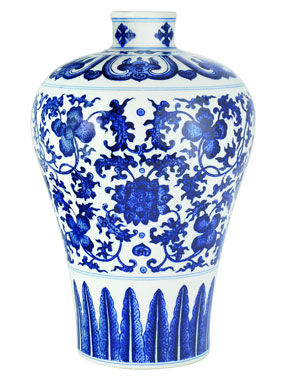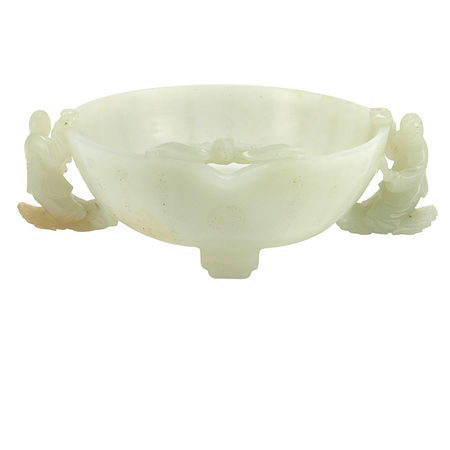Asian Works of Art @ Doyle New York
Imperial Chinese Zitan Side Table, 18th Century. The three-sectioned rectangular-form top set within a wide frame and carved along the outer edge with dragons amid swirling clouds, above a narrow plain waist and a band of bats flying amid stylized clouds, bordered below by lotus petal lappets, the straight sided apron with a central ruyi-shaped scroll densely carved with two opposing dragons chasing a flaming pearl and further dragons amid clouds extending down the exterior sides of the four square sectioned legs all terminating in hoof feet with rockwork and resting on two later floor stretchers. Height 35 3/4 inches, width 63 1/2 inches, depth 16 3/4 inches. C Property from the Estates of Walter and Sonja Caron Stein. Estimate $500,000 - $700,000. Photo: Courtesy Doyle New York.
NEW YORK, NY.- Doyle New York, one of the world’s leading auctioneers and appraisers, will hold an auction of Asian Works of Art on Monday, September 13, 2010 at 10am (EST). The sale offers over 430 lots showcasing the arts of China, Japan, Korea and Southeast Asia dating from the Neolithic Period through the 20th century. Offerings include porcelain and pottery, jade, ivories, scholar's objects, bronzes, swords, textiles, screens and paintings. The public is invited to the exhibition on view from Friday, September 10 through Sunday, September 12. Doyle New York is located at 175 East 87th Street in New York City.
Highlighting the auction is an 18th century Chinese Imperial zitan side table from the Estates of Walter and Sonja Caron Stein of Long Island, New York. Estimated at $500,000-700,000 USD, this exquisitely carved table, or changzhuo, is crafted of rare zitan wood -- a commodity so expensive and highly-prized that existing stores of it were safeguarded in the Imperial warehouse and restricted for use by the Imperial Palace Workshop. An Imperial provenance is also suggested by the table’s carved borders of five-clawed dragons, a symbol of the Emperor. The table is additionally decorated with borders of bats, representing happiness.
“Early Chinese furniture of zitan wood is highly sought-after, because of its rarity and its Imperial connections, “ said Marley Rabstenek, Doyle New York’s specialist in charge of the sale. "A table such as this is certain to generate excitement among the world’s most important collectors of Chinese furniture.”
Chinese porcelains in the September 13 auction are highlighted by a Chinese blue and white glazed Meiping bearing the Qianlong Seal Mark and of the Period (1736-1795). In a private collection since the 1950s, the Meiping measures 9.75 inches in height and bears an estimate of $150,000-200,000 USD. Exceptional artistic and technical talent is evidenced in this piece, as it emulates designs of early Ming blue and white wares. The use of the heaping and piling of the brilliant cobalt blue on the bright white ground is further testimony to the precision of the craftsmen who worked the Imperial kilns during the Qianlong Period, most likely under the watchful eye of Tang Yin. Tang Yin supervised the Imperial kilns during the Yongzheng and Qianlong Periods, during which time indisputably the finest wares were produced.
Chinese Blue and White Glazed Meiping, Qianlong Seal Mark and of the Period. Estimate $150,000 - $200,000. Photo: Courtesy Doyle New York. Delicately drawn with a wide band of foliate lotus and leafy vines between upright overlapping plantain leaves at the foot and pendant lotus panels on the shoulder, the neck with four stylized flowerheads, above a small border of stylized double peach and scrolls. Height 9 3/4 inches. The selection of Chinese jades in the sale features an Qing Dynasty white jade diminutive pouring vessel of rounded form decorated with a carved bat and estimated at $30,000-50,000 USD. Chinese White Jade Pouring Vessel. Qing Dynasty Of rounded form, on three bracket feet, the spout partially covered by a bat with spread wings, two figures grasping the rim to form the handles. Diameter 4 1/2 inches. Estimate $30,000-50,000. Photo: Courtesy Doyle New York. The fully-illustrated auction catalogue may be viewed online at http://www.doylenewyork.com.
For a similar example see Christie's, Hong Kong, Master Works of Chinese Art, November 5 & 6, 1997, lot 977
Provenance:
Purchased in the 1950s, then passed by descent to the current owner.
The combined shape and decoration of this vase is very rare. The closest example is the meiping worked in red and white sold at Christie's, Hong Kong which is cited above. Other related examples are an oviform jar from the Jingguantang Collection sold at Christie's on November 3, 1996, lot 552 and the H.Q. Havemeyer Collection Qianlong marked covered ewer with similar lotus scrolls, now in the Metropolitan Museum, New York which is illustrated by Valenstein, A Handbook of Chinese Ceramics, p. 259. Exceptional artistic and technical talent is evidenced in this piece as it emulates designs of early Ming blue and white wares. The use of the heaping and piling of the brilliant cobalt blue on the bright white ground is further testimony to the precision of the craftsmen who worked the imperial kilns during the Qianlong Period most likely under the watchful eye of Tang Yin. Tang Yin supervised the imperial kilns during the Yongzheng and Qianlong Periods during which time indisputably the finest wares were produced.
C Property of a Private Collector

/https%3A%2F%2Fprofilepics.canalblog.com%2Fprofilepics%2F1%2F0%2F100183.jpg)





/http%3A%2F%2Fstorage.canalblog.com%2F43%2F34%2F577050%2F65866509_o.jpg)
/http%3A%2F%2Fstorage.canalblog.com%2F89%2F17%2F577050%2F65835561_o.jpg)
/http%3A%2F%2Fstorage.canalblog.com%2F65%2F69%2F119589%2F65765172_p.jpg)
/http%3A%2F%2Fstorage.canalblog.com%2F27%2F67%2F119589%2F65244452_p.jpg)